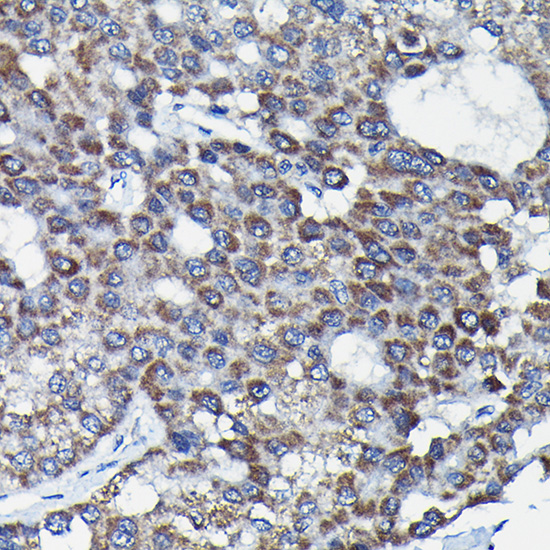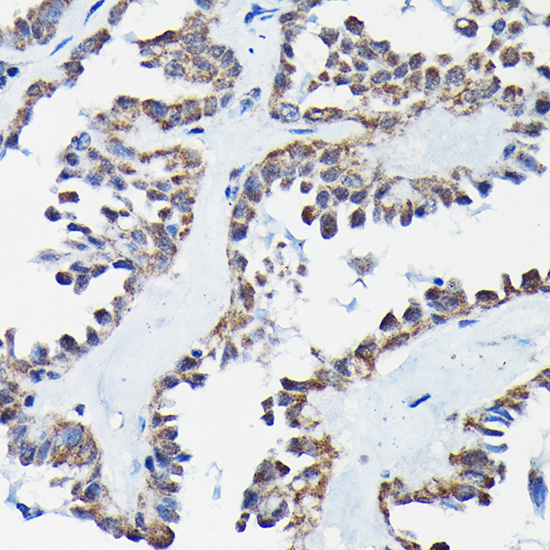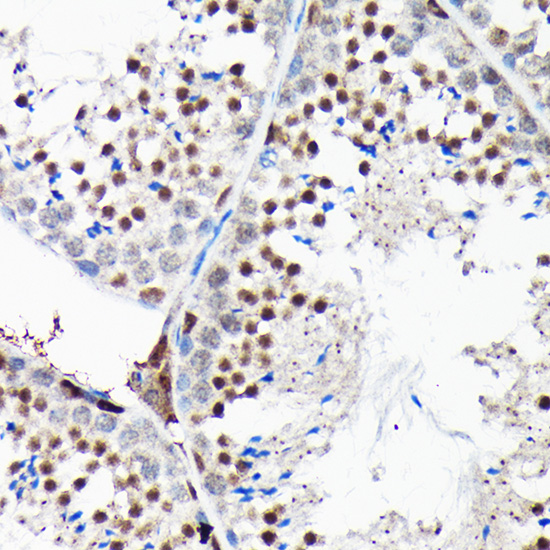Cell Cycle Antibodies 2
Anti-RGS14 Antibody (CAB9962)
- SKU:
- CAB9962
- Product Type:
- Antibody
- Applications:
- WB
- Reactivity:
- Human
- Reactivity:
- Mouse
- Host Species:
- Rabbit
- Isotype:
- IgG
- Research Area:
- Cell Cycle
Description
| Antibody Name: | Anti-RGS14 Antibody |
| Antibody SKU: | CAB9962 |
| Antibody Size: | 20uL, 50uL, 100uL |
| Application: | WB IHC |
| Reactivity: | Human, Mouse, Rat |
| Host Species: | Rabbit |
| Immunogen: | Recombinant fusion protein containing a sequence corresponding to amino acids 230-510 of human RGS14 (NP_006471.2). |
| Application: | WB IHC |
| Recommended Dilution: | WB 1:500 - 1:2000 IHC 1:50 - 1:200 |
| Reactivity: | Human, Mouse, Rat |
| Positive Samples: | SH-SY5Y, Mouse kidney |
| Immunogen: | Recombinant fusion protein containing a sequence corresponding to amino acids 230-510 of human RGS14 (NP_006471.2). |
| Purification Method: | Affinity purification |
| Storage Buffer: | Store at -20'C. Avoid freeze / thaw cycles. Buffer: PBS with 0.02% sodium azide, 50% glycerol, pH7.3. |
| Isotype: | IgG |
| Sequence: | PPVE GPGG RPLR KSFR RELG GTAN AALR RESQ GSLN SSAS LDLG FLAF VSSK SESH RKSL GSTE GESE SRPG KYCC VYLP DGTA SLAL ARPG LTIR DMLA GICE KRGL SLPD IKVY LVGN EQAL VLDQ DCTV LADQ EVRL ENRI TFEL ELTA LERV VRIS AKPT KRLQ EALQ PILE KHGL SPLE VVLH RPGE KQPL DLGK LVSS VAAQ RLVL DTLP GVKI SKAR DKSP CRSQ GCPP RTQD KATH PPPA SPSS LVKV PSSA TGKR QTCD IEGL VELL NRVQ S |
| Gene ID: | 10636 |
| Uniprot: | O43566 |
| Cellular Location: | Cell junction, Cell membrane, Cell projection, Cytoplasm, Membrane, Nucleus, PML body, centrosome, cytoskeleton, dendrite, dendritic spine, microtubule organizing center, postsynaptic cell membrane, postsynaptic density, spindle, spindle pole, synapse |
| Calculated MW: | 21kDa/36kDa/44kDa/61kDa |
| Observed MW: | 54kDa |
| Synonyms: | RGS14 |
| Background: | This gene encodes a member of the regulator of G-protein signaling family. This protein contains one RGS domain, two Raf-like Ras-binding domains (RBDs), and one GoLoco domain. The protein attenuates the signaling activity of G-proteins by binding, through its GoLoco domain, to specific types of activated, GTP-bound G alpha subunits. Acting as a GTPase activating protein (GAP), the protein increases the rate of conversion of the GTP to GDP. This hydrolysis allows the G alpha subunits to bind G beta/gamma subunit heterodimers, forming inactive G-protein heterotrimers, thereby terminating the signal. Alternate transcriptional splice variants of this gene have been observed but have not been thoroughly characterized. |
| UniProt Protein Function: | RGS14: Acts as a regulator of G protein signaling (RGS). Modulates G protein alpha subunits nucleotide exchange and hydrolysis activities by functioning either as a GTPase-activating protein (GAP), thereby driving G protein alpha subunits into their inactive GDP-bound form, or as a GDP-dissociation inhibitor (GDI). Confers GDI activity on G(i) alpha subunits GNAI1 and GNAI3, but not G(o) alpha subunit GNAO1 and G(i) alpha subunit GNAI2. Confers GAP activity on G(o) alpha subunit GNAI0 and G(i) alpha subunits GNAI2 and GNAI3. May act as a scaffold integrating G protein and Ras/Raf MAPkinase signaling pathways. Inhibits platelet-derived growth factor (PDGF)-stimulated ERK1/ERK2 phosphorylation; a process depending on its interaction with HRAS1 and that is reversed by G(i) alpha subunit GNAI1. Acts as a positive modulator of microtubule polymerisation and spindle organization through a G(i)-alpha-dependent mechanism. Plays a role in cell division. Probably required for the nerve growth factor (NGF)-mediated neurite outgrowth. May be involved in visual memory processing capacity and hippocampal-based learning and memory. 4 isoforms of the human protein are produced by alternative splicing. |
| UniProt Protein Details: | Protein type:GAPs, RGS; GAPs Chromosomal Location of Human Ortholog: 5q35.3 Cellular Component: centrosome; cytoplasm; dendrite; dendritic spine; nuclear body; nucleus; plasma membrane; postsynaptic density; spindle; spindle pole Molecular Function:GDP-dissociation inhibitor activity; GTPase activator activity; microtubule binding; protein binding; receptor signaling complex scaffold activity; receptor signaling protein activity Biological Process: cell division; chromosome segregation; learning; long-term memory; negative regulation of MAP kinase activity; negative regulation of synaptic plasticity; nucleocytoplasmic transport; platelet-derived growth factor receptor signaling pathway; positive regulation of neurogenesis; regulation of transcription in response to stress; response to oxidative stress; spindle organization and biogenesis; visual learning; zygote asymmetric cell division |
| NCBI Summary: | This gene encodes a member of the regulator of G-protein signaling family. This protein contains one RGS domain, two Raf-like Ras-binding domains (RBDs), and one GoLoco domain. The protein attenuates the signaling activity of G-proteins by binding, through its GoLoco domain, to specific types of activated, GTP-bound G alpha subunits. Acting as a GTPase activating protein (GAP), the protein increases the rate of conversion of the GTP to GDP. This hydrolysis allows the G alpha subunits to bind G beta/gamma subunit heterodimers, forming inactive G-protein heterotrimers, thereby terminating the signal. Alternate transcriptional splice variants of this gene have been observed but have not been thoroughly characterized. [provided by RefSeq, Jul 2008] |
| UniProt Code: | O43566 |
| NCBI GenInfo Identifier: | 257051088 |
| NCBI Gene ID: | 10636 |
| NCBI Accession: | O43566.4 |
| UniProt Secondary Accession: | O43566,O43565, Q506M1, Q6ZWA4, Q8TD62, |
| UniProt Related Accession: | O43566 |
| Molecular Weight: | 36,922 Da |
| NCBI Full Name: | Regulator of G-protein signaling 14 |
| NCBI Synonym Full Names: | regulator of G-protein signaling 14 |
| NCBI Official Symbol: | RGS14 |
| NCBI Protein Information: | regulator of G-protein signaling 14 |
| UniProt Protein Name: | Regulator of G-protein signaling 14 |
| Protein Family: | Regulator of G-protein signaling |
| UniProt Gene Name: | RGS14 |
| UniProt Entry Name: | RGS14_HUMAN |











